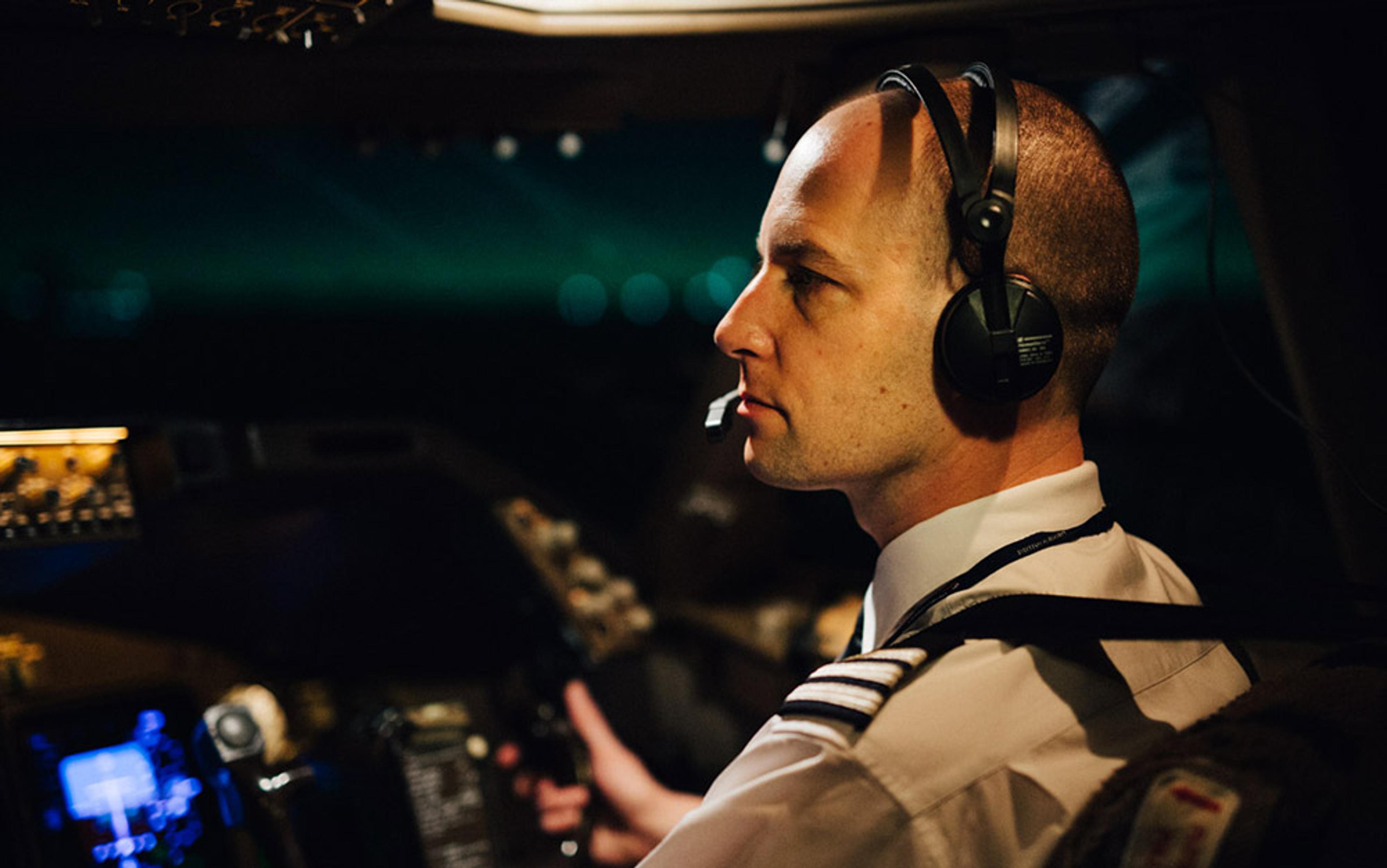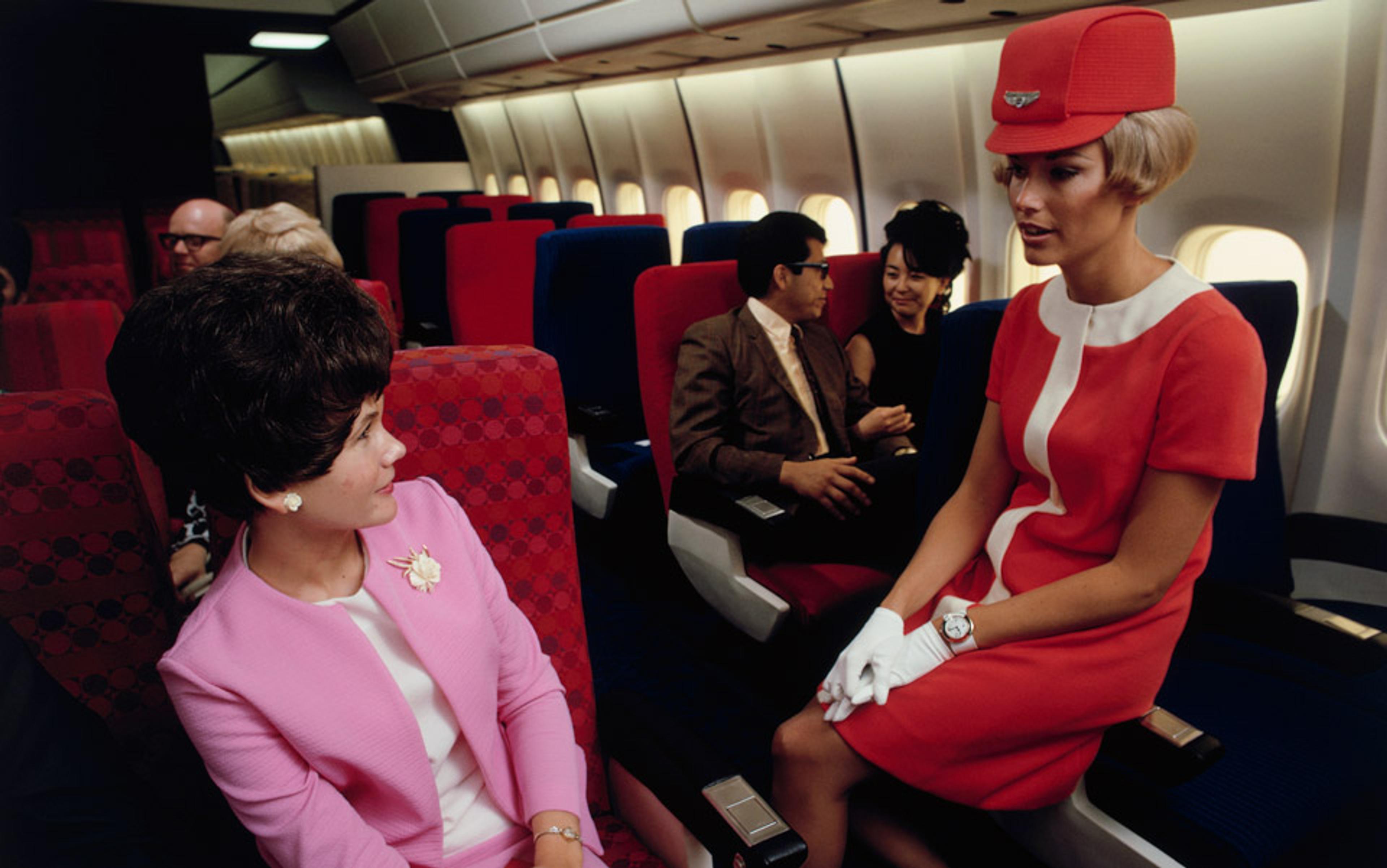The day I first flew in the cockpit of an airliner, I fell in love with the sights, of course, but also the sounds. I wasn’t a pilot then, not yet. I was a passenger on a British Airways Boeing 747, on a flight from Tokyo to London. I was a business traveller in those days, a management consultant and accustomed to flying, but still a big kid when it came to anything to do with airplanes.
I asked one of the flight attendants if I could visit the cockpit, as I always did before the attacks of 11 September 2001. Soon I was heading up to meet the pilots in ‘the pointy end’ (their term) for a long chat somewhere over Russia. Later in the flight, the pilots – one of whom I’d later fly with as a pilot myself, in that exact same 747 – invited me back to the cockpit for the arrival at Heathrow.
Strapped by a five-point harness into a seat behind the grey-haired captain, I was dumbstruck by the sight of the North Sea, and the Thames Estuary, and then of London itself, its sprawling, miniaturised perfections all the more miraculous after so many long hours over the forests and tundra of Siberia. As we descended over St Paul’s and the bridges and parks, all I could think was that this was London, the ordinary, present hour of an ancient city, and that we were coming to it from Tokyo – Tokyo! – and from the sky.
I fell in love with what I saw from the airplane that day. But I was equally struck by the clipped, technical majesty of the words I heard through the expensive-looking noise-cancelling headset the pilots had handed to me. The pilots spoke of ‘localisers’ and ‘glideslopes’ and ‘veerefs plus five’ (VREF, I now know, is a baseline landing speed). On the radio they talked, in terms I could barely understand, to a series of laconic folks who identified themselves as ‘Maastricht Control’ and ‘London Centre’ and the all-powerful-sounding ‘Heathrow Director’. And the plane itself spoke out loud as we neared the ground, announcing our heights and then, all of a sudden, asking us in a brisk, clear voice, to ‘DECIDE.’
Decide what, I wondered? To become a pilot, I figured. And so a couple of years after first hearing the language of the sky, I was a pilot myself, listening to a busy frequency on the ground at Heathrow, waiting for a gap in which to ask the controller for permission to start our engines.
Thirteen years later, I still love my job, enough to have a book about my work. And I still love the language of the sky.

The author at the controls. Photo by Greg Funnell
I like that it’s universal, nothing less than we’d expect from a realm of human endeavour that’s been such a symbol and a catalyst of this age of globalisation. I like that the language of the sky is so hidden, and yet it’s always being spoken. When I fly as a passenger, that language is what’s going on at the front – at the pointy end – of the same plane in which I’m doing the crossword or devouring reruns of 30 Rock. And when I’m sitting in the backyard with a cup of coffee and a book, it’s bouncing all around the cloudless blue above me, as it is at all hours in the skies above Honolulu and Cairo and Ulaanbaatar, above everywhere.
I like how different the language of the sky is from everyday English – indeed, we might give it its own name, Aeroese (though it’s also sometimes, and less aspirationally, called Aviation English). Above all, I love how Aeroese can somehow manage, in its technical, obscuring precision, to capture the high romance of flight – an aspect of my job, no matter how much I love it, that in the cockpit we rarely have reason to consider directly.
A prominent feature of Aeroese is its deep nautical roots. Think port and starboard, forward and aft; deck; log; captain and first officer; bulkhead, hold and galley; rudder and tiller; wake; knot; even waves, as in mountain waves, an atmospheric disturbance that can produce turbulence. And of course the word aeronautical itself.
In a profession that, for all its joys, often seems to lack deep traditions, I like that aviation has borrowed much of its language (and its uniforms) from the older world of the sea. This heritage is something I went out of my way to capture in the title of my book, Skyfaring: A Journey with a Pilot (2015). Seafaring is a word I’ve always loved – it makes me think of icy masts, and charts held in place by oil lamps, and of Herman Melville’s Moby-Dick (1851), written a mile or so from my childhood home in western Massachusetts, which so carefully chronicles and sanctifies the language of the sea. Skyfaring, then, I convinced my editors; a word I thought I’d coined, until I found it was the title of a poem by William Watson published in the late 19th century, some years before the Wright Brothers got airborne.
The sky’s great linguistic debt to the sea is a pleasing thought when I’m flying a 747 over the open ocean and we spy a lonely vessel plowing across the fields of deep blue below, or when we fly into an air-port that is near a major seaport, as those of Singapore, Vancouver, Boston and so many others are, and see freighters and tankers and the occasional cruise ship waiting patiently to dock as we zoom overhead to a port of our own.
Another characteristic of Aeroese (like legalese) is its strong resemblance to English. A jet’s great speed lets us cross over lands and their languages almost as easily as I did when, as a teenager, I flipped through the pages of an atlas. Imagine a plane that flies from London to Bangkok. The pilots speak first to British air-traffic controllers but, just a few minutes after takeoff, the British controllers hand them over to Belgian or Dutch ones, who soon pass them to German controllers, and then to Czech, to Hungarian, to Romanian, to Turkish, to Iranian ones, and so on.
In flight, pilots are listening not just to controllers, but also to other pilots – Thai pilots returning from Paris, Russian pilots on their way to the Maldives, and pretty much every other conceivable combination of origin, destination, flag and crew nationality. The whole world is in the sky.
In place of a control tower of Babel, there is a sphere of English that sits as simply as air around the whole planet
It’s hard to imagine a system more in need of a common language. And that language is English (or English-derived Aeroese). When a Venezuelan pilot speaks to a New York air-traffic controller, or when a pilot from Brooklyn speaks to a controller in Caracas, they speak in English. It’s something to marvel at, the first time you fly to Tokyo, say, and you hear an exchange between a Japanese pilot and a Japanese air-traffic controller, both speaking carefully in Japanese-accented English. It’s standardisation and globalisation by force of bare necessity, by force of speed.
There are exceptions – places where controllers may speak to local pilots in a shared first language. This often occurs in France, for example, when a French pilot arrives in French skies. It also occurs when longhaul French pilots cross the aerial borders into the administrative airspace region of the Canadian sky known as Montréal. But every airline pilot flying internationally can speak English, and usually does.
I like the word atmosphere, for no other reason than because we so rarely think of the air as a sphere, one that floats just above and envelops the heavier world of land and water. In place of what would otherwise be a control tower of Babel, there is a sphere of English, too, that sits as simply as air around the whole planet. Planes and words move quickly through it, above all the places where people wake up in the morning and speak Tagalog or Finnish or Hausa without any reason to think of the language above them.
In the same way that English fills the airwaves, it fills the machine itself. When I first moved to Europe, I was surprised to find that the buttons on domestic appliances such as ovens (even those bought in the United Kingdom) were rarely identified with helpful words such as ‘bake’ or ‘high’. Instead, they were typically marked by symbols or numbers, a design protocol that makes it easy to sell the same appliance in many countries. But to me the symbols were confusing (particularly the weeping asterisk on my oven’s control panel) and many of my local friends agreed.
Airplane manufacturers, who try to sell across the whole world, face an extreme version of the situation confronted by European home-appliance manufacturers – and in the design of cockpits, far more so than that of toasters, confusion isn’t an option. So in the planes made by Boeing and Airbus (the two leading companies, which I refer to below), pretty much everything that’s written in the cockpit is in English, or English-derived acronyms. That’s true whether the jet rolled out of a factory in Renton, Washington, or Toulouse, France, or Tianjin, China – and whether the customer is Russian or Swedish or Chilean.
Each Boeing or Airbus airplane is sold with an entire library of associated technical manuals. They’re all in English, too (a particularly remarkable fact for Airbus, which is headquartered in France). A small number of airlines might translate these manuals – an expensive endeavour, and a never-ending one, as the manuals are frequently updated. Such costs explain why so many stick with the English versions, even if that’s not the first language of most (if any) of the pilots who will use them.
The same is generally true of the checklists that pilots read to one another at key points in a flight. These checklists – a sheet of laminated paper or, increasingly, a display on a computer screen – are a simple but critical component of flight safety (see ‘The Checklist’ (2007) by Atul Gawande in The New Yorker). German or Japanese pilots will talk about their lunch or the weather on the horizon in German or Japanese, but when it’s time, for example, for the After Takeoff checklist to be read, they’ll switch, seamlessly and briefly, to English (as discussed in ‘The Ecology of Language Practices in Worldwide Airline Flight Deck Operations’ (2006), a fascinating paper on how Japanese crews mix English and Japanese in the cockpit).
‘DECIDE’, the plane implores, a decision-making tool that could be deployed in meeting rooms in the corporate world or academia
It’s also worth noting that Airbus and Boeing have distinct dialects of Aeroese. For example, there’s a system on airliners that we can regard as a sort of cruise control (though that’s not a perfect analogy). On Boeings, it’s the autothrottle; on Airbus jets, it’s the autothrust. The fully stowed position of the flaps, the panels that extend from the wing for takeoff and landing, is up on Boeings, but zero on Airbus. For pilots, learning a new airplane’s dialect can be one of the more challenging parts of switching from one aircraft type to another.
It might surprise some passengers to learn that airplanes themselves speak, out loud, at various stages of flight. Edwin Hutchins of the University of California, San Diego, the lead author of that paper on Japanese cockpits, told me of a particularly good reason for the airplane itself to speak English: ‘It’s a question of certification. Verbal callouts are part of the installed equipment in the airplane’ – a point he notes also applies to the electronic checklists that increasingly fill the modern cockpit. We often joke that you can’t change a lightbulb on a plane without a stack of paperwork. So when planes speak, they speak English, and more often than not with a male voice: ‘TRAFFIC, TRAFFIC’, to call our attention to another airplane; ‘ONE HUNDRED’, among other heights, as we come in to land; ‘MONITOR RADAR DISPLAY’ in certain weather conditions.
My favourite airplane vocalisation is the ‘DECIDE’ call, which I first heard on that 747 flight from Tokyo to London, when I was a wide-eyed and wide-eared guest in the cockpit. The ‘DECIDE’ call comes in a female, English-accented voice (on the 747s that I fly) that we hear as we reach the altitude or height at which we must either have sight of the runway environment or break off the approach. ‘DECIDE’, the plane implores, a decision-making tool that I’ve occasionally wondered about turning into an app to be deployed in meeting rooms in the corporate world or academia. Career counsellors might like it too – it certainly worked for me.
Aeroese is perhaps most different from conversational English when it’s spoken on the radio. Brevity here is of the essence, because only one person can speak at a time (if more than one aircraft transmits at the same time, both are garbled). Clarity of meaning is important, for obvious reasons, and clarity of speech is important, too, because often English isn’t the first language of either the speaker or listener, and the quality of transmission isn’t always assured. (Although this was more of a consideration in the static-filled days of yore; these days, short-range radios are clearer to me than a landline telephone.) And on the radio, of course, you don’t know who’s speaking, or who’s being addressed – there’s no eye contact, and one controller is speaking to many pilots, none of whom you can see, either.
It’s much like a conference call of the sort that I knew in my management consulting job, except that folks are constantly joining and leaving, and also they’re flying past each other at hundreds of miles an hour.
We didn’t evolve to function in such a linguistic environment, and so Aeroese (like radio communications in other contexts and industries) has evolved instead. One widespread adaptation is the use of callsigns, a unique ‘name’ used to identify a flight. The callsign assigned to a flight is generally a version of the company name and the flight number. At British Airways, where I work, callsigns usually begin with Speedbird; other particularly cool ones are Ice Air, for Icelandair, and Reach, for US military flights run by the Air Mobility Command. ‘London Control, good morning, Speedbird 117, flight level 340’ is what I’d say to a London controller on my first contact as the pilot of British Airways flight 117, from around 34,000 feet (though see an excerpt from my book in The New York Times for a discussion on what it really means to be at 34,000 feet).
Controllers use a sort of callsign as well. These generally have a geographic element, like London Control. My favourites are SoCal (Southern California) Approach, for the controllers who guide flights into Los Angeles; Atlantico, for controllers who cover a huge swath of the central and southern Atlantic Ocean; and Heathrow Director, for the steely eyed Brits who carefully sequence arrivals at Europe’s busiest airport.
Other frequencies, such as those a company might use for maintenance, have their own callsigns. The office that handles onboard manuals and documentation at British Airways has the callsign Speedbird Library, which still makes me smile, as if on the other end of the line was a tweed-clad archivist in an Oxbridge-caliber Gothic hall, carefully preserving and organising the paper records of a much-storied airline.
There’s no fat in the system: it would take up precious airtime, and might introduce confusion. ‘The excessive use of courtesies should be avoided,’ warn our dour manuals.
Another defining (and simplifying) feature of radio Aeroese is its small vocabulary. Indeed, in addition to callsigns and numbers, the words regularly used in everyday air-traffic communications probably amount to only a few dozen. Even these few words are subject to usage and pronunciation rules designed to correct the shortcomings of quotidian English.
For example, we’re instructed to pronounce three as ‘TREE’ and nine as ‘NINER’, and 25,000 as ‘two-five thousand’ (more specifically, ‘TOO FIFE TOUSAND’), not ‘twenty-five thousand’, because experience has shown that these modified pronunciations are less likely to be misunderstood. Or, when a controller knows you’re waiting to speak, they won’t say, ‘go ahead’, because that could indicate approval of something they didn’t hear you ask for. Instead they’ll say: ‘Pass your message.’
If all this sounds prescriptive and rigid, it is. Our exchanges are almost purely transactional. There’s no fat in the system, because it would take up precious airtime, and at worst it might introduce confusion. ‘The excessive use of courtesies should be avoided,’ warn our dour manuals.
So what does Aeroese actually sound like on the radio? You can listen to certain air-traffic frequencies online – although most exchanges contain terms and certainly nuances that wouldn’t be apparent to non-Aeroese speakers. ‘Descend flight level 100, then reduce minimum clean.’ ‘Establish localiser two-seven-right, when established descend glide.’ And: ‘Check 63 north 40 west 1830 flight level 340 estimate 64 north 50 west 19 hundred CLAVY next.’ These examples from recent flights of mine I wouldn’t have been able to begin to make sense of as a teenager, even one who loved airplanes and read all he could about them.
Aeroese is also distinguished by its warm embrace of acronyms and abbreviations. Huge tables of these acronyms appear at the start of many manuals, and they’re a (very, very geeky) joy to browse.
ASDA is Accelerate Stop Distance Available, an important measure of runway length (but by no means the only one). BKN is Broken (as in clouds, not airplanes). BOBCAT is a good one – Bay of Bengal Cooperative Air Traffic Flow Management System (more or less), which regulates flights from Singapore to Europe, for example. CM, blessedly, is just centimetres. LTGCW is Lightning Cloud-to-Water (as opposed to Cloud-to-Ground, Cloud-to-Air or Cloud-to-Cloud, among other varietals of lightning).
MALS is Medium Intensity Approach Lighting System, not to be confused with MALSR – Medium Intensity Approach Lighting System with Runway Alignment Indicator Lights. OCC is Occulting (as in light, not witchcraft). NEG is ‘No/Negative/Permission not granted/That is not correct’, which reminds me of a Mad magazine issue from long ago, in which, in fine print – below a fake coupon, perhaps – was written something like ‘Void where prohibited. Prohibited where void. Void and prohibited where not allowed.’ SNBNK is Snowbank(s) Caused by Plowing. UP is Unidentified Precipitation (cats and dogs? Brimstone?)
angels are ‘an echo caused by physical phenomena not discernible to the eye… sometimes attributed to insects or birds flying in the radar beam’
Though Aeroese has predominantly English roots, a handful of common meteorological abbreviations have French origins (as do the words fuselage and aileron, of course). BR is Mist (brouillard) GR is Hail (grêle); HN is Sunset to Sunrise (horaire de nuit). MI is Shallow (a usage derived from mince) and BC is Patches (from bancs). I used some of these for years and never once wondered where they came from, until I researched them for my book.
An only slightly less geeky pleasure are the startlingly precise definitions that Aeroese specifies for everyday English words. These are specified in the voluminous, accuracy-obsessed ‘Definitions’ sections of our manuals.
Pleasingly, accuracy itself is defined: ‘a degree of conformance between the estimated or measured value and the true value’. Air, you must be wondering, is ‘the mixture of gasses found in the atmosphere’. And aircraft? Why, that’s ‘any machine that can derive support in the atmosphere from the reactions of the air other than the reactions of the air against the Earth’s surface’. In a heavens-transiting industry, angels are ‘an “echo” caused by physical phenomena not discernible to the eye… sometimes attributed to insects or birds flying in the radar beam’.
Blowing sand sounds straightforward enough, but really, have you ever tried to define it? How about ‘a type of lithometeor composed of sand picked up locally from the surface and blown about in clouds or sheets’. Dry snow ‘can be blown if loose, or, if compacted by hand, will fall apart on release’, while Wet snow, ‘if compacted by hand, will stick together and tend to form a snowball; specific gravity: 0.35 up to but not including 0.5’. Terrain is important, but it sounds obvious, so much so that I never thought about how to define it: ‘the continuous surface that exists at the bare earth, the top of the [forest] canopy or something in-between, also known as the “first reflective surface”’.
Before I was either a pilot or a writer, I was a teenager whose obsessions, aside from airplanes, included browsing dictionaries, encyclopaedias and atlases, and staring at samples of languages that I’d never heard of, let alone studied. In my late 20s, when I finally started training to become a pilot, I was happy to realise how fascinating the sky is for anyone who loves words.
And anyway, it’s not all rules and rigidity. If you ever have a chance to listen to air-traffic controllers, you might enjoy the five-letter waypoint names that they and pilots use to identify geographic positions in the sky. There are thousands of these, and their format reflects the familiar limitations of Aeroese. So each is designed to be pronounceable, at least once you get the hang of the format – such as ZAMAN, near Omaha; SUTKO, near Newfoundland; KOMOR, near the Senegal and Guinea-Bissau border. But also, in case there’s any ambiguity, these names are rapidly spellable using the phonetic alphabet – Alpha, Bravo, etc.
when the auroras are brightening the sky, you’ll hear a pilot broadcast to every cockpit in range: ‘Not a bad job on a night like this’
Many waypoint names are gibberish, but others are more colourful – DRAKE in the English Channel (for Sir Francis); BARBQ near Kansas City; WHALE in the Mediterranean, off Benghazi. When descending to Portsmouth, New Hampshire, fans of the Tweety and Sylvester cartoons will enjoy this sequence: ITAWT ITAWA PUDYE TTATT (followed by IDEED). The authorities in the US, more than most countries, have made a habit of writing five-letter distillations of history and culture onto the sky; as passengers never encounter them, this is for no reason other than that it might be fun for pilots to fly to and from them. And so it is.
On many airliners there’s a satellite phone (often called the Batphone) that we can use to call air-traffic centres, doctors (in the event of an ill passenger) or our colleagues on the ground. During these calls, though we still use the radio panel and headset, it’s easy to slip into normal, easygoing conversation. And, of course, normal conversation is what we use when we talk to each other in the cockpit about something other than work. Whether in the long and quiet hours over Siberia, or over a leisurely breakfast in São Paulo, this is a great job for stories (and for endless variations of jokes from the movie Airplane!).
There’s also a frequency that pilots use to speak to each other, typically when over the open ocean. Officially it’s the ‘Air-to-Air Communications Channel’, but informally we call it the ‘chat’ frequency. The frequency is easy to remember: 123.45 MHz. We typically use it to exchange turbulence reports and other operational information. But, occasionally, it really is used for chatting. And sometimes, when the auroras are brightening the sky or yet one more light- and wish-trailing meteor has zipped across the heavens, you’ll hear a pilot broadcast to every cockpit in range: ‘Not a bad job on a night like this, is it?’ There should be an acronym for that feeling, I sometimes think, but then I look up from the instruments, into the starriest of nights, and I’m glad that there isn’t.






